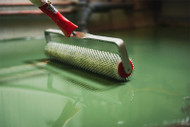Green roofs have gained popularity and sustainability over the last few hours. They are widely popular in commercial buildings and provide numerous environmental benefits. They provide eco-friendly and aesthetically pleasing solutions to contribute to environmental sustainability and incorporate green roofs through positive energy efficiency, air quality, and urban ecosystems.
Epoxy resin and its versatile properties increase the innovative ways to enhance the performance and durability of the green roof in maximum ways. This article reflects on the uses of epoxy resin in green roofs for commercial buildings and their advantages.
- Waterproofing Membranes
Epoxy resin plays a crucial role in creating effective waterproofing membranes for green roofs. These membranes serve as a protective layer between the roof structure and vegetation, preventing water infiltration into the building. Epoxy Resin-based membranes ensure exceptional waterproofing properties under the roof in dry and structural conditions. The seamless and flexible nature of epoxy resin allows easy application to adhere to different substrates, providing a reliable, long-lasting waterproofing solution for commercial green roofs.
2. Root Barriers
To prevent damage to the roof structure from plant roots, a root barrier is necessary for green roof systems. Epoxy resin can be used to create robust root barriers that effectively block root penetration. The epoxy resin forms a strong barrier that restricts root growth, protecting the roofing materials from potential damage and maintaining the integrity of the roof. This innovative application of epoxy resin on green roofs ensures a harmonious coexistence between the vegetation and the building, allowing for the benefits of a green roof while minimizing any risks associated with root intrusion.
3. Edge Detailing
Epoxy resin is also utilized in the edge detailing of green roofs, providing a secure and durable finish. The edges of green roofs require careful attention to prevent water seepage and plant displacement. Epoxy resin can be applied as a protective coating along the edges, creating a watertight seal and reinforcing the boundary between the roof and the vegetation. This innovative use of epoxy resin ensures that the green roof remains intact and resilient, with no compromises in terms of water resistance or stability.
4. Structural Enhancements.
Innovative applications of epoxy resin extend beyond waterproofing and root barriers. Epoxy resin is used to reinforce the structural components of the green roof system, like lightweight concrete and composite panels. By impregnating the materials with epoxy resin and enhancing their strength and rigidity, their significance is effectively enhanced. The use of epoxy resin in structural enhancements promotes sustainable design as it optimizes material usage while maintaining structural integrity. Epoxy resin overall reflects the enhancement.
5. Environmental Benefits:
Incorporating green roofs with epoxy resin supports environmental sustainability by improving energy efficiency and air quality. They contribute positively to urban ecosystems, creating healthier living spaces.
6. Long-Term Durability:
The use of epoxy resin ensures the longevity of green roof systems, reducing maintenance needs and prolonging service life. This durability makes green roofs a wise investment for commercial buildings.
By integrating epoxy resin into green roofs, commercial buildings can achieve enhanced performance, contribute to sustainability, and create healthier urban environments.
Conclusion:
Epoxy resin and its properties reflect an innovative solution to improving the performance and longevity of green roofs in commercial buildings. The waterproof membranes, root barriers, and structural enhancements play a vital role in ensuring green roof systems. Epoxy resin plays a vital role in facilitating the integration of sustainable and environmentally friendly practices in commercial construction. By incorporating green roofs, commercial buildings can enhance sustainability, create healthier environments for occupants, and contribute to the overall well-being of urban ecosystems. The inclusion of epoxy further reflects on the major protective layer.

